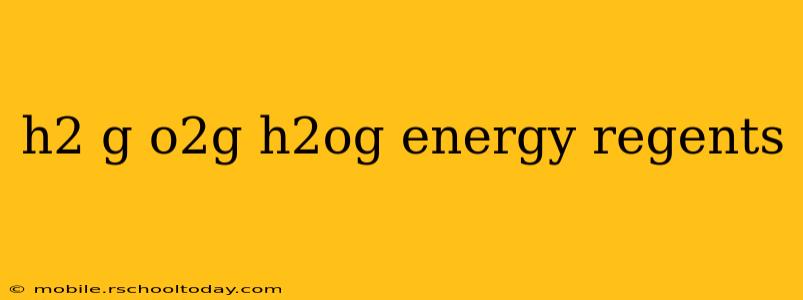Understanding the H2, O2, & H2O Energy Relationship in Regents Chemistry
The Regents Chemistry exam often tests your understanding of energy changes in chemical reactions, particularly those involving hydrogen (H₂), oxygen (O₂), and water (H₂O). These three substances are fundamental to understanding concepts like combustion, bond energy, and enthalpy changes. Let's break down the key relationships and how they relate to the Regents exam.
What is the energy change when H2 and O2 react to form H2O?
The reaction of hydrogen gas (H₂) and oxygen gas (O₂) to form liquid water (H₂O) is a highly exothermic reaction. This means it releases a significant amount of energy in the form of heat. The balanced chemical equation is:
2H₂(g) + O₂(g) → 2H₂O(l) + energy
This energy release is due to the formation of strong O-H bonds in water. The energy required to break the H-H and O=O bonds is less than the energy released when the O-H bonds are formed. The difference is the energy released as heat. This is a key concept in understanding enthalpy (ΔH) and Hess's Law, both frequently tested on the Regents.
How does bond energy relate to the energy change in this reaction?
Bond energy is the amount of energy required to break a chemical bond. To understand the energy change in the formation of water, we need to consider the bond energies of the reactants and products.
- Reactants: Energy is required to break the H-H bonds in H₂ and the O=O bond in O₂.
- Products: Energy is released when the O-H bonds are formed in H₂O.
The overall energy change is the difference between the energy required to break the bonds in the reactants and the energy released when the bonds are formed in the products. Since more energy is released in bond formation than is required for bond breakage, the reaction is exothermic.
Is the reaction of hydrogen and oxygen endothermic or exothermic?
As discussed above, the reaction of hydrogen and oxygen to form water is exothermic. The negative enthalpy change (ΔH < 0) indicates that energy is released to the surroundings. This is why hydrogen combustion is a powerful source of energy.
What are some real-world applications of this reaction?
The exothermic reaction between hydrogen and oxygen has numerous applications:
- Fuel Cells: Hydrogen fuel cells utilize this reaction to generate electricity, producing only water as a byproduct, making it a clean energy source.
- Rocket Propulsion: The high energy release makes this reaction ideal for rocket propulsion systems.
- Welding: The intense heat produced can be used in welding applications.
How is the energy change in this reaction measured?
The energy change in this reaction can be measured using calorimetry. A calorimeter is a device that measures the heat absorbed or released during a chemical reaction. By measuring the temperature change of the water surrounding the reaction, the heat released (or absorbed) can be calculated using the specific heat capacity of water. This allows for the determination of the enthalpy change (ΔH) for the reaction.
This comprehensive explanation covers the fundamental aspects of the energy relationship between H₂, O₂, and H₂O, providing a solid foundation for success on the Regents Chemistry exam. Remember to review related concepts like enthalpy, Hess's Law, and bond energy to fully grasp the nuances of this important reaction.
